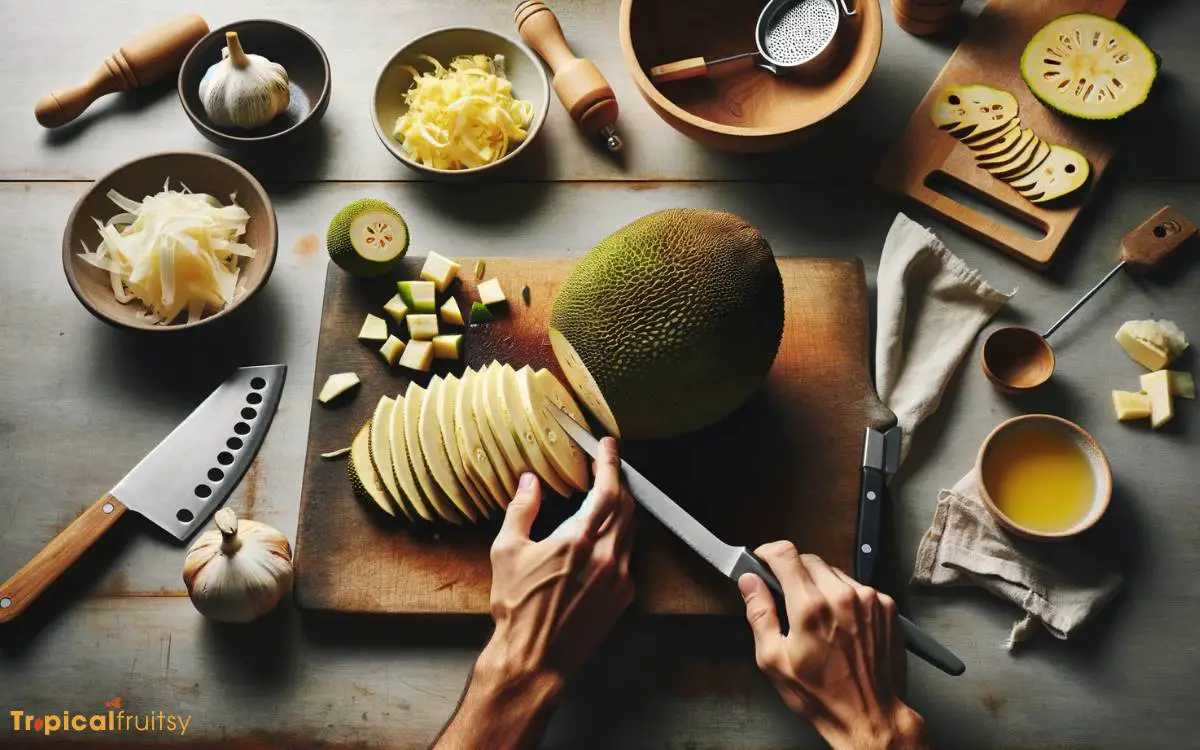How Do You Cook Breadfruit? Simple and Delicious Ways!
Cooking breadfruit involves simple steps: selecting a ripe fruit, peeling, coring, slicing, and choosing a cooking method such as boiling, roasting, frying, or grilling.
Each method enhances its flavor and texture, making breadfruit a versatile ingredient in various dishes.
Breadfruit preparation begins with:
- Selecting a ripe fruit with green to yellow skin.
- Peeling the skin and removing the inedible core.
- Slicing the fruit into pieces according to the recipe.
Cooking methods include:
- Boiling: Softens the fruit for mashes or salads.
- Roasting: Offers a richer, caramelized flavor.
- Frying: Creates a crispy texture, ideal for snacks.
- Grilling: Imparts a smoky taste, perfect for barbecues.
Breadfruit can be adapted to many recipes, serving as a nutritious and tasty element in your meals.
Discover the tropical delight of breadfruit in your kitchen with these easy preparation and cooking techniques.

Key Takeaway
Food Cooking Methods & Recipes
| Cooking Method | Preparation Steps | Cooking Time | Suitable Recipes |
|---|---|---|---|
| Boiling | Peel, core, slice | 12-15 min | Salads, mashes |
| Roasting | Peel, core, slice | 30-40 min | Side dishes, stuffings |
| Frying | Peel, core, slice | 3-5 min | Snacks, chips |
| Grilling | Peel, core, slice | 10-15 min | Barbecue, sandwiches |
Selecting the Perfect Breadfruit

Choosing the right breadfruit is essential to ensure the best flavor and texture in your dish. Identifying a prime specimen is a nuanced art, balancing ripeness with firmness.
Seek out breadfruits with a greenish-yellow hue and a slight give under pressure, indicating maturity without overripeness. The skin should be blemish-free, and the stem emits a sweet, fragrant sap when it’s at its peak.
A mature breadfruit, when sliced, reveals a creamy, starch-rich heart, devoid of any dark spots. This tropical staple can transform from a potato-like ingredient to a dessert-worthy treat, depending on its stage of ripeness.
Connoisseurs appreciate the subtle differences, understanding that the choice of breadfruit can elevate a simple meal to a culinary experience.
Prepping Your Breadfruit

Once you have selected an ideal breadfruit, the first step in preparation is to wash the fruit thoroughly under running water to remove any surface dirt or debris.
This ensures that your culinary canvas is pristine, and no unwelcome grit mars the texture of your dish.
With the fruit clean, the next task is to slice off the stem and base, creating stable surfaces for further cutting.
A sharp knife is essential here as the breadfruit’s skin can be quite tough. Gently score the skin, taking care not to pierce deeply into the succulent flesh.
Peel away the outer layer with care, revealing the creamy interior, ripe for transformation. As you remove the core and section the fruit, envision the sumptuous meals that your preparation will soon yield.
Boiling Breadfruit Basics

After prepping your breadfruit by peeling and cutting, boiling is a simple method that transforms the starchy fruit into a tender and versatile ingredient.
To boil breadfruit, begin by submerging the chunks in a pot of cold water, ensuring the liquid covers them completely. Add a pinch of salt to the water to infuse the breadfruit with a subtle flavor.
Bring the water to a rolling boil over high heat, then reduce to a simmer, allowing the breadfruit to cook until it achieves a soft, potato-like consistency, typically within 20 to 30 minutes.
Test for doneness with a fork; if it slides in easily, the breadfruit is ready. Drain the water and serve the breadfruit as a side or use it as a base for further culinary exploration.
Roasting Breadfruit Methods

Transitioning from the simmering pots to the sizzle of roasting, breadfruit’s versatility shines through in its ability to absorb the smoky flavors of an open flame.
Mastering the art of roasting breadfruit begins with understanding the nuances of the open flame technique, which imparts a distinct char and a depth of flavor unmatched by other methods.
Open Flame Technique
Roasting breadfruit over an open flame is a traditional method that imparts a smoky flavor and a unique texture to this versatile tropical staple.
This technique, often favored in various cultures, celebrates the fruit’s natural taste while enhancing its culinary potential.
Here’s how to elevate the open flame roasting experience:
- Preheat the fire: Ensure your flame is medium-hot for consistent cooking.
- Prepare the fruit: Wash and pat dry, then make a small incision to vent steam.
- Monitor closely: Turn regularly for an even char on all sides.
- Test for doneness: Flesh should yield to a gentle press; skin appears blistered.
- Rest before serving: Allow it to cool slightly for easier handling and peeling.
As the breadfruit rests, let’s turn up the heat on another popular method—oven roasting, which offers a more controlled environment for cooking.
Oven Roasting Tips
Oven roasting breadfruit is an efficient method that provides a consistent heat source, ensuring even cooking and a delightful caramelization of the fruit’s sugars.
To achieve optimum results, preheat your oven to a temperature of 350-400°F (175-200°C). Begin by slicing the breadfruit into even wedges, removing the heart and skin.
Lightly coat the pieces with olive oil and your choice of seasonings to enhance the fruit’s inherent sweetness and complex flavor profile.
Arrange the wedges on a baking sheet lined with parchment paper, ensuring they are not overcrowded to promote uniform roasting. The breadfruit should be tender and golden brown after approximately 30-40 minutes.
Charcoal Grill Variation
Another method to bring out the rich flavors of breadfruit is by roasting it on a charcoal grill, which imparts a distinct smoky taste unachievable through oven roasting.
This traditional technique can transform the starchy fruit into a delicacy with a remarkable depth of flavor.
To achieve the best results:
- Preheat the grill: Ensure coals are white-hot for even cooking.
- Prepare the breadfruit: Slice into wedges or keep whole, depending on preference.
- Monitor the heat: Maintain a consistent temperature for thorough roasting.
- Turn regularly: Rotate the breadfruit to char evenly without burning.
- Test for doneness: The breadfruit should be soft inside and crispy on the outside.
This culinary approach is not only a nod to time-honored practices but also a journey into the heart of breadfruit’s potential.
Frying Up Breadfruit

Frying breadfruit unlocks a dimension of culinary delight. It is characterized by a golden exterior and a tender heart. The choice of oil is pivotal, as it not only influences the flavor but also affects the achievement of that coveted crispy texture.
Expert tips can elevate the simple act of frying into an art form. These tips ensure that each morsel of fried breadfruit is a harmonious blend of crunch and softness.
Oil Selection
When selecting an oil for frying breadfruit, consider a high smoke point oil such as canola, vegetable, or coconut oil to ensure a crisp exterior without burning.
These oils are adept at withstanding the high temperatures necessary for frying without degrading, which promotes a better-tasting result.
To convey the importance of the right oil selection, consider the following:
- Canola Oil: Neutral flavor and cost-effective for high-heat cooking.
- Vegetable Oil: A versatile choice, often a blend of several oils.
- Coconut Oil: Adds a subtle tropical flavor, complementing the breadfruit.
- Refined Oils: Typically have higher smoke points than unrefined.
- Health Considerations: Some oils offer more heart-healthy fats than others.
Each oil brings its own set of attributes that can enhance the frying process.
Crispy Texture Tips
To achieve a crispy texture when frying breadfruit, it is essential to maintain the oil at a consistent high temperature.
This practice ensures that the exterior of the breadfruit slices quickly develops a golden-brown crust, sealing in moisture and creating a delightful contrast to the soft interior. The table below illustrates key considerations for attaining that perfect crunch.
| Aspect | Tip | Reasoning |
|---|---|---|
| Oil Temperature | 350-375°F (175-190°C) | Optimal range for crisping |
| Breadfruit Prep | Thin slices or cubes | Increases surface area for crisping |
| Frying Duration | Until golden brown | Ensures a crunchy exterior |
| Post-Frying | Drain on paper towels | Removes excess oil |
Utilizing these tips will endow your breadfruit with a satisfying snap that complements its creamy flesh. With the crispy texture mastered, let’s turn our focus to the subtleties of grilling breadfruit to perfection.
Grilling Breadfruit Techniques

Grilling breadfruit unlocks its natural sweetness and imparts a smoky flavor that we can enhance with various seasonings and marinades.
To perfect this method, consider the following techniques:
- Preheat the grill to a medium-high heat to ensure even cooking.
- Slice the breadfruit into wedges or rounds, maintaining consistent thickness for uniform grilling.
- Brush the slices with oil to prevent sticking and to help the exterior develop a crispy char.
- Experiment with marinades like a blend of soy sauce, garlic, and herbs for a savory twist, or a mixture of honey and cinnamon for a sweet profile.
- Rotate the pieces occasionally to achieve well-defined grill marks and avoid burning.
Breadfruit in Baking

Incorporating breadfruit into baked goods infuses them with a subtle sweetness and moist texture, making it a unique ingredient for inventive recipes ranging from breads to desserts.
As breadfruit flourishes in tropical regions, it offers a gluten-free alternative to traditional flours, inviting a myriad of culinary explorations.
Its versatility shines when it’s pureed and integrated into the batter of cakes and muffins, imparting a dense yet tender crumb.
The starchy composition of breadfruit also lends itself well to heartier fare, such as artisanal bread and pastries.
When preparing these dough-based delicacies, breadfruit can be mashed and folded into the mix, contributing to a delightful sponginess and nuanced flavor profile that distinguishes it from its wheat-based counterparts.
Serving and Pairing Ideas

How might one complement the distinctive taste of breadfruit when serving it as part of a meal or culinary creation?
The unique flavor profile of breadfruit, which ranges from a potato-like taste when underripe to a sweet, custardy flavor when fully ripe, makes it a versatile canvas for various culinary pairings.
To enhance its taste and incorporate it seamlessly into your gastronomic repertoire, consider the following pairings:
- Coconut Milk: Enhances the tropical notes of ripe breadfruit in stews and curries.
- Cinnamon & Nutmeg: Adds warmth and complexity to breadfruit dishes, especially desserts.
- Cured Meats: Offers a savory contrast to the breadfruit’s subtle sweetness, ideal in mixed platters.
- Citrus Juices: Brightens the flavor in breadfruit salads and salsas.
- Spicy Peppers: Injects a kick that complements the starchy texture, perfect for stir-fries or roasted preparations.
What Are Some Simple and Delicious Ways to Cook Breadfruit?
When it comes to picking breadfruit for roasting, there are plenty of simple and delicious ways to prepare this versatile fruit. You can roast breadfruit chunks with a drizzle of olive oil and your favorite spices, or even mash it into a creamy puree for a unique side dish.
How Long to Boil Breadfruit

Boiling breadfruit is a common method of preparation, and the cooking time can vary depending on the size and ripeness of the breadfruit.
Here’s a general guideline:
- Preparation: First, peel the breadfruit and cut it into even-sized pieces. This helps in cooking it uniformly.
- Boiling: Place the pieces in a large pot and cover them with water. Add a pinch of salt if desired. Bring the water to a boil.
- Cooking Time: Once the water is boiling, reduce the heat to a simmer. The breadfruit typically takes about 15 to 30 minutes to cook, but the exact time can vary. The key is to check the tenderness of the breadfruit. It should be fork-tender, similar to the consistency of cooked potatoes.
- Testing for Doneness: To test if it’s done, insert a fork or knife into a piece of breadfruit. It should go in easily without any resistance.
- Serving: Once cooked, drain the water and let the breadfruit cool for a few minutes. It can be served as is, or you can add additional seasonings or ingredients to enhance its flavor.
Remember, the ripeness of the breadfruit can affect the cooking time. Riper breadfruit may cook faster than less ripe ones. It’s always a good idea to start checking for doneness after about 15 minutes of boiling.
Conclusion
The versatility of breadfruit is a culinary revelation, offering a spectrum of textures and flavors depending on the method of preparation.
Whether boiled, roasted, fried, grilled, or baked, this starchy bounty adapts, inviting innovation in the kitchen.
The final pairing of such dishes promises a symphony of taste, yet the full potential of breadfruit remains a tantalizing mystery, challenging cooks to explore its depths. The journey from tree to table continues to unfold with each creative endeavor.






